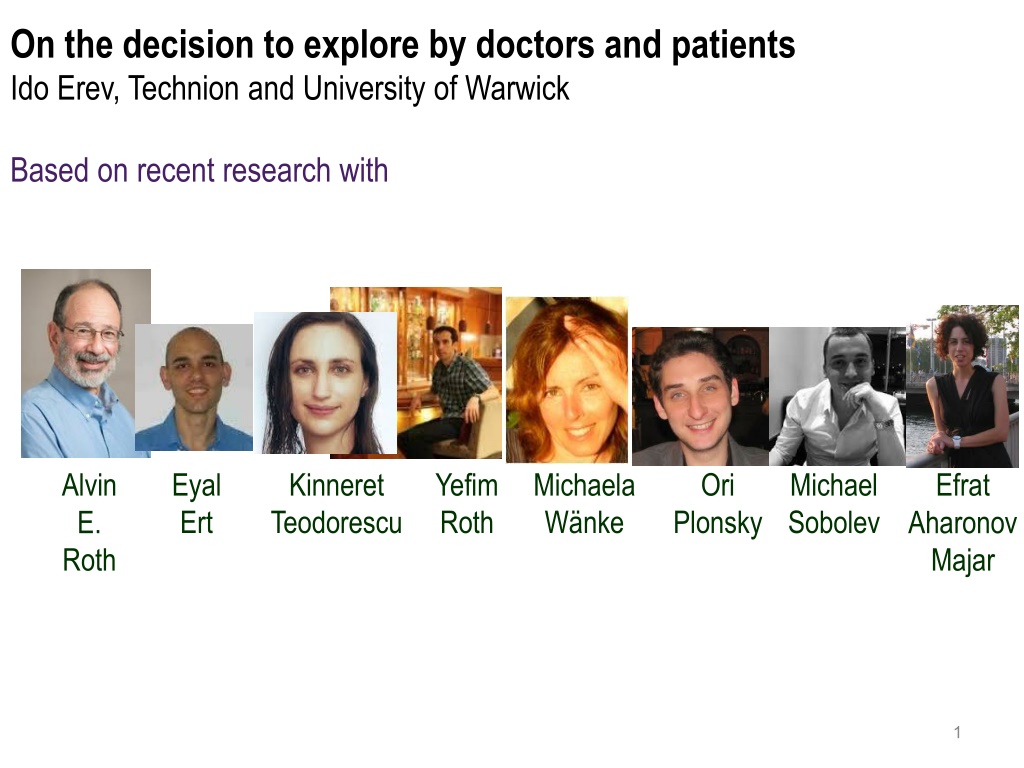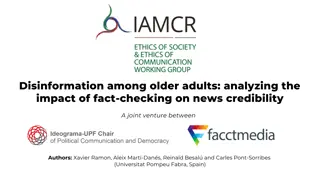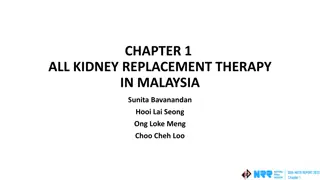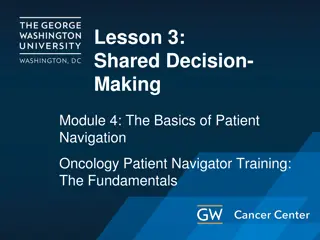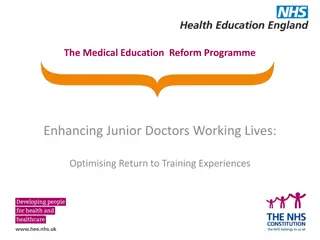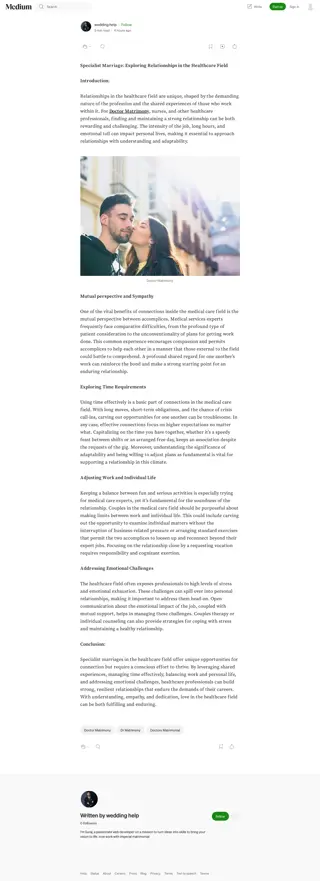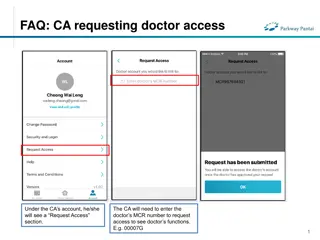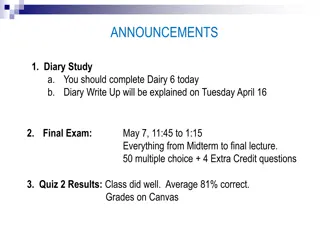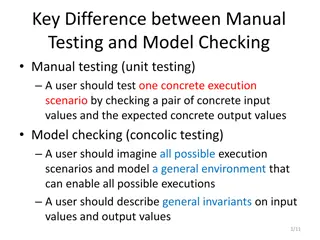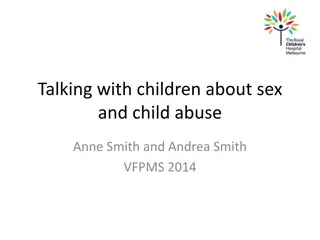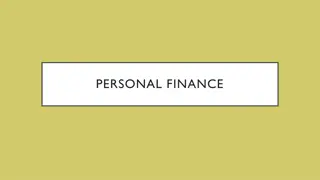Understanding the Decision-Making Process of Checking Behaviors Among Doctors and Patients
Recent research by Ido Erev from Technion and University of Warwick, along with Alvin E. Roth and others, explores the coexistence of insufficient and over-checking behaviors among individuals, including doctors and patients. The study delves into the factors influencing checking decisions, highlighting the impact of incentives, perceived costs, and behavioral tendencies. Insights from various trials and experiments shed light on the complexities of decision-making and the potential consequences of both inadequate and excessive checking behaviors.
Download Presentation

Please find below an Image/Link to download the presentation.
The content on the website is provided AS IS for your information and personal use only. It may not be sold, licensed, or shared on other websites without obtaining consent from the author. Download presentation by click this link. If you encounter any issues during the download, it is possible that the publisher has removed the file from their server.
E N D
Presentation Transcript
On the decision to explore by doctors and patients Ido Erev, Technion and University of Warwick Based on recent research with Alvin E. Roth Eyal Ert Kinneret Teodorescu Yefim Roth Michaela W nke Ori Michael Sobolev Efrat Plonsky Aharonov Majar 1
The coexistence of insufficient and over-checking Yefim Roth, Michaela W nke, Ido Erev There are many situations in which people do not check enough (Marotta Wurgler, 2007): More than 99% of surfers accept e-contracts without reading them. And in some cases doctors remove the wrong foot. In other situations people appear to check too much. As demonstrated in Gigerenzer s talks, the cost of unnecessary cancer screening can be extremely high. Part of the deviations from the socially optimal actions can be a reflection of problematic incentives (e.g., bonuses for doctors), and confusing descriptions. We consider the role of another contributor to deviations from optimal checking. (The fact that we think that incentives are important, does not mean that behavioral insights are not important. We study the behavioral impact of incentives)
We hypothesize that checking decisions are similar to other decisions from experience. They reflect a tendency to rely on small samples. Thus, insufficient checking is likely when checking maximizes expected payoff, but its typical effect is negative. Too much checking is likely when checking maximizes expected payoff, but its typical effect is negative.
Studies 1 and 2: 100 trials, 48 subjects In each trial the subject choose between Check and continue and receive full feedback Example Check Continue Sample of 5 Check rate 40% Contracts/ description New Messages/ screening 30% +1 in 90%, -1 otherwise* +1 in 90%; -10 otherwise +2 in 90%; -11 otherwise 0* 64% 65% *higher expected return
Study 4 In each trial one key (A or B) pays +10, and the other key pays -10 Check discovers the best key, but costs 9 Continue requires a guess (EV = 0) Example Check Continue Sample of 5 Check rate 40% Two options Move to choose between A and B One pay +10, and the second -10 20% +1
The effect of the cost reduction and bonuses Event E: Finding a treasure, P(E)= 0.1 Outcome when not checking: A: 10 if E; -1 otherwise (EV= 0.1) B: 0 Outcome when checking: Max(A,B) - Cost EV when checking: 0.1(10-Cost) - 0.9(Cost) (checking is always optimal) # Cost Benefit from checking +0.4 typical Out. -0.2 Samp. of 5 33% Check rate Basic 0.2 with p =.75; 1.4 otherwise 0.04 with p =.75; 0.28 otherwise -0.2 with p =.75; 1 otherwise 18% Basic divided by 5 Basic plus a bonus of 0.4 +0.8 -0.04 36% 27% 60% +0.8 +0.2 64%
Summary of the checking study: The similarity of the pharmacy industry to organized crime (Gotzsche, 2013), does not mean that all the deviations from optimal checking reflect problematic incentives. Some unnecessary tests are taken because the common outcome is good (the patient learns that he does not have cancer), and the negative outcomes are rare. Deviations of this type can be addressed by changing the typical outcome. Painful or costly procedures (to reduce too much screening), and bonuses (to increase insufficient screening).
Diversification and exploration The Big Eye effect (Ben Zion et al., 2010, Grosskopf, Yechiam & Erev., 2006) x ~ N(0,300), y ~ N(0, 300) R1: x (EV = 0) R2: y (EV = 0) M: Mean(R1,R2) + 5 (EV = 5) 1 0.8 Asset M Prop 0.6 0.4 Deviation from: maximization, risk aversion, loss aversion. Implies under-diversification Robust to prior information 0.2 0 1 10 30 50 70 90 Trial The hot stove effect (Mark Twain; Denrell & March, 2001; Hogarth & Einhorn, 1992). 8
Giving up too early and over-exploration (Teodorescu & Erev, 2013): Many behavioral problems appear to reflects insufficient exploration, but in other cases people appear to exhibit over-exploration. EV -0.1 +0.1 Problem Rare disasters: 10% disasters (-10), 90% rewards (+1) Problem Rare treasure: 10% treasures (+10), 90% disappointments (-1) The two stage explanation: An initial choice whether to explore (partially based on a small sample), and then a choice between the alternatives. 9
Learned helplessness (Seligman, 1975) Experimental group With Control Stage Training Task Dogs were exposed to shocks applied to their foot pads while restrained in a hammock. Flat panels located on either side of the dog would immediately terminate shock if pressed by side-to- side movement of its head. Yoked Each dog in this group was wired in parallel with a dog from the "With Control" group to control for equal durations and timing of shocks. These dogs experienced the shocks as inescapable. Identical Test Task Both groups were placed in a shuttle box, exposed to escape- avoidance training. The required response in order to avoid shock was jumping over a hurdle into an adjacent compartment. 90% of dogs readily learned the escape avoidance response. Results 2/3 of dogs failed to escape shock. Instead of jumping over the hurdle they laid down huddling passively in the corner. 10
Two explanations: 1.Learning that the agent has no control 2.Underweight rare events Group Practice Cost of exploration Loss of 1 Test Cost of exploration Loss of 1 Potential benefit Potential benefit No control +10 if another agent finds a treasure (x% of cells) +10 if the agent finds a treasure (x% of cells) +10 if the agent finds a treasure (x% of cells) With Control Loss of 1 x+10 if the agent finds a treasure (x% of cells) Loss of 1 X 10 20 100 Practice w/o control 40,40 40,45 40 90 Practice with control 45, 40 70,70 90, 90 11
An idea Consider situations in which doctors over-test, and over-treat, but underexplore (invest limited time to talk with patients about the impact of the treatment). This pattern can be a result of problematic incentives, and of a tendency to rely on small samples. One solution to these problems is to propose controlled experiment that produce a fact box for each patient. When possible, the patient will be offered to take two packages of the medicine (two different drugs, or a drug and a placebo), and run an experiment: take each package for a month, and enter some measures to project site. The doctor and the patient will meet again to look at the fact box in two months. This can facilitate exploration, and reduce overtreatment and maybe even over-testing.
Learning from the mistakes of others, and the Werther effect Efrat Aharonov-Majar, Michael Sobolev, Ido Erev, Technion On May 24, 2015, John and Alicia Nash were killed in a taxi crash because they did not wear seatbelts. This sad news increased my tendency to wear seatbelt in the back seat of a cab. In other cases people do not appear to learn from the mistakes of others. One example is the Werther effect or copycat suicide (Phillips, 1974; Stack, 2000). Another example is copycat behavior by anorectic patients.
The current paper tries to improve our understanding of the impact of information concerning the mistakes made by others. Better understanding of this impact will help predict the effect of campaigns that try to fight accidents by publicizing the mistakes (or reckless behavior) that triggered them, and the outcomes of these mistakes. It will also help understand the effect of high but rare fines. Previous research shows that in individual choice tasks people tend to underweight rare events, and for that reason gentle and frequent fines, are more effective than high but rare fines (Barron & Erev, 2003). It is possible that rare fines are much more effective when they are publicized, and people can learn from the mistakes of others.
The value of campaigns that publicize mistakes and fines is likely to increase when the receivers of the information can use it to avoid similar mistakes. But it is likely to decrease when the new information inspires problematic exploration. Observing failures can reveal something new about the set of feasible strategies. We try to evaluate the relative importance of the two effects by studying a variant of the clicking paradigm that allows inspired exploration.
Study 1: The typing paradigm Method: 100 trials, in each trial the subjects were asked to type two letters, and then received a payoff in Shekels. The payoff rule was +2 with p = 0.95, -40 otherwise, if the second letter was Upper case (EV = -.1) +1 with p = 0.5, -1 otherwise, if the second letter was lower case (EV= 0) Please type two letters: a f Your payoff for this trial is +1
Method: 100 trials, in each trial the subjects were asked to type two letters, and then received a payoff in Shekels. The payoff rule was +2 with p = 0.95, -40 otherwise, if the second letter was upper case (EV = -.1) +1 with p = 0.5, -1 otherwise, if the second letter was lower case (EV= 0) Please type two letters: z k Your payoff for this trial is -1
Method: 100 trials, in each trial the subjects were asked to type two letters, and then received a payoff in Shekels. The payoff rule was +2 with p = 0.95, -40 otherwise, if the second letter was upper case (EV = -.1) +1 with p = 0.5, -1 otherwise, if the second letter was lower case (EV= 0) Please type two letters: Another player in this experiment chose cW and his payoff was -40 c Q Your payoff for this trial is +2
Two conditions: Risky default: The default is upper case Safe default: The default is lower case First -40 message in trial 23 Proportion of Upper case (Bad choices, -40, +2) 100% 90% Risky default: The default is upper case. 80% 70% Bad choices 60% 50% 40% 30% 20% Safe default: The default is lower case. 10% 0% 1 2 3 4 5 Block of 20 trials N=34
Behavior before and after observation Default Lower case 50% 40% 30% 20% 37% 33% 31% 10% 0% Just before -40 Ad Immediately after -40 Ad 2 trials after -40 Ad
Study 2: Same as study1 without default: The subjects were asked to try both upper and lower case (for five trials during the first ten). This change decreases the role of inspired exploration. The payoffs were Bad: +2 with p = 0.95, -40 otherwise, Upper case (EV = -.1) Good: +1 with p = 0.5, -1 otherwise, if lower case (EV= 0) 90% 80% 70% 60% Bad Choices 50% 40% 30% 20% 10% 0% 1 2 3 4 5 Block N=48
In the current setting, the negative effect of observing mistakes by others (inspired exploration of similar strategies) is larger than the positive effect (avoiding similar mistake). This observation clarifies the robustness of the tendency to underweight rare events and behave as if it wont happen to me. In some settings the observation that it happened to others just increases this reckless behavior. We are sure that publicizing mistakes can be effective in some cases (like in the John Nash example), but it seems that the effectiveness is smaller than the common as a deterrent belief.
The inventions-discoveries puzzle and the joint effect of incentives and behavioral insights (Erev & Roth, 2014) Review of the most successful inventions and discoveries in the social sciences reveals an apparent inconsistency. The best inventions (e.g., trading, markets, contracts, law enforcement, banks, auctions, medical insurance and health care systems) are methods to reduce conflicts under the assumption that people maximize expected return, and the most elegant discoveries are demonstrations of deviations from maximization (e.g., Kahneman & Tversky, 1979). We suggest that the gap is a reflection of the fact that maximization based inventions are successful when they create conditions that facilitate quick learning to select the desirable actions. Behavioral research (or insights) are likely to be most effective when they clarify these conditions.
Summary: It is important to distinguish between two classes of behavioral phenomena that affect choice behavior. A wide set of initial overgeneralizations Over-discrimination following experience: A tendency to rely on the most similar past experiences that implies near maximization, but can lead to underweighting of rare events and deviations from optimal explorations. Successful inventions appear to create incentives in which people learn to select the option that maximize their return (and lead to good social outcomes). We believe that many medical decisions making problems can be addressed in similar ways. The nudge approach is likely to be most effective when it is impossible to change the incentives, but behavioral insights are extremely important even when we try to change the incentives
